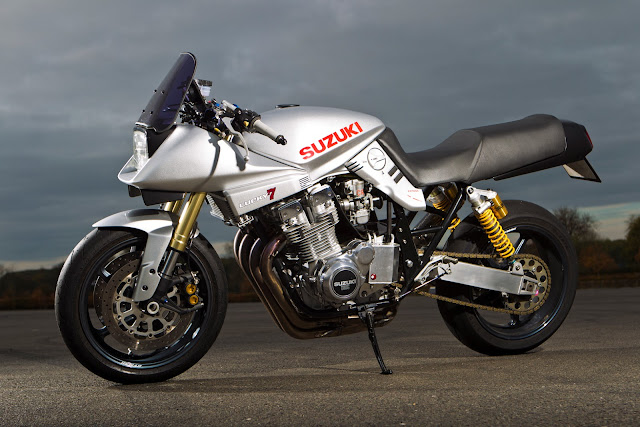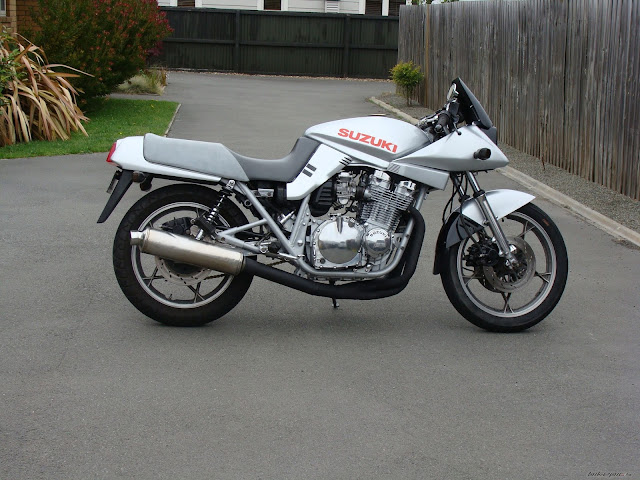The Katana's sleek and integrated style was a welcome departure following years of Japanese multis with conventional look and riding position. Although the nose fairing and tiny screen gave minimal wind protection, they combined with the fairly low handlebars to improve high-speed comfort. This bike’s four- into-one exhaust and remote-reservoir shocks are later additions.
The Katana 1100 that Suzuki unleashed on an unsuspecting motorcycle world in 1982 was a machine like nothing seen before from Japan. It was bold, stylish, imaginative, breathtaking: very different to the succession of fast but visually dull models that had preceded it. And underneath all the fancy bodyw'ork, the Katana was an outstanding superbike too.
Katana was the Japanese word for a Samurai warrior’s ceremonial sword, and it fitted Suzuki’s sharp new silver blade perfectly. With its pointed nose, tiny flyscreen. low clip-on handlebars and swooping tank-seat section, the Katana was a unique machine with an infinitely more aggressive image than the GSXl 100 roadster to which it was closely related.
This landmark in the history of Japanese superbike development had partly European parentage. The Katana had been shaped by the German group Target Design (which had also been responsible for BMW's striking R90S almost a decade earlier). Although some riders criticized the Suzuki for being more notable for style than practicality, most welcomed the alternative to the formatted 'Universal Japanese Motorcycle' with its four-cylinder engine and unfaired, upright riding position that provided no wind protection.
Suzuki had the ideal basis for the Katana in the 1075cc air-cooled engine from the GSXl 100. with its 16 valves, phenomenally broad spread of power, and reputation for reliability. To give the new bike extra teeth, the motor w'as tuned with a modified airbox, reworked carburettors, new exhaust camshaft and lightened alternator. It produced a maximum of 11 lbhp at 850()rpm. a useful 1 lbhp up on the standard unit.
Chassis layout remained conventional, and the twin-cradle steel frame was unchanged, but many parts were new. Suspension was stiffened at both ends, new triple clamps gave a shallower steering angle for added stability, and the front forks gained a hydraulic anti-dive system claimed to be similar to that of Suzuki’s 5()()cc grand prix racers.
Breathtaking acceleration
The Katana looked lightning fast when standing still, and when moving it was much, much faster. The big GSX motor was already a superb powerplant, with huge reserves of instant midrange torque. The Katana had breathtaking acceleration - and even more urge at the top end. Top speed was a genuine 140mph (225km/h). And the Katana's stretched-forward riding position, with its welcome bit of wind protection from the small screen, made that performance more usable than that of most rivals.
Handling was very good for such a big, heavy bike. The fairing and screen were solidly mounted, so contributing to the Katana’s impressive highspeed stability. The firm suspension gave a level of control (and discomfort) that was almost Italian, marred only by the anti-dive’s occasional tendency to make the forks lock up over a series of bumps. The triple-disc brake system worked well, even in the wet, though this could not be said of the standard fitment tyres.
Inevitably, the radical Katana did not suit every rider or every occasion. Its suspension was harsh and uncomfortable in town, its seat was hard, and its steering was quite heavy at slow speed. But this was not a bike to be ridden at slow speed. Its purposeful nature was an integral part of its appeal. At last, this was a Japanese bike that provided both performance, handling and style, at a sensible price.
The Katana was a huge hit. and remained popular for years. Suzuki broadened the Katana range with a lOOOcc version with slide carbs for production racing, watered-down middleweight models, and even pocket-sized 250 and 400cc replicas for the Japanese market. Years later they even restarted production of a ‘special edition" Katana 1100 that w;as almost identical to the original. Fair reward for a brave and brilliant bike.
Firm suspension and an anti-dive front suspension system, developed from the one fitted to Suzuki's grand prix racebikes, helped stive the big Katana excellent handling by Japanese superbike standards St:. k tyres and gent clearance encouraged enthusiastic corner in ? provided the road was dr .
Suzuki’s 1075cc, air-cooled 16-valve engine had been introduced with the conventionally styled GSXI100 in I960, two years before the Katana's arrival. Its four-valves-per- cylinder layout, called TSCC (or Twin Swirl Combustion Chamber) by Suzuki, gave superbly strong mid-range output.
Specification Suzuki GSX1100S Katana (1982)
- Engine Air-cooled dohc 16-valve four
- Capacity 1075cc (72 x 66mm)
- Maximum power 111 bhp @ 8500rpm
- Transmission Five-speed, chain final drive
- Frame Steel twin downtube
- Suspension Telescopic front; twin shocks rear
- Brakes Twin discs front; disc rear
- Weight 545lb (247kg) wet
- Top speed 140mph (225km/h)






















0 comments: